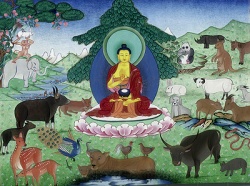Buddhism & Animals
AMIDA TRUST Occasional paper BUDDHISM & ANIMALS Based on a talk given at Quaker Concern for Animals, May 2005 by Dharmavidya David Brazier Buddhism offers a religious vision at three levels.
At the ultimate level, the Dharma refers to our existing in the midst of a limitless ocean of grace called the Dharmakaya that is beyond our understanding. This then appears in spiritual experience at the level called sambhogakaya - the "enjoyment body" - which corresponds with the mystical centring of our being upon the influx of spirit - the enjoying of the bliss of
samadhi. Samadhi is the consummate vision, the light that illumines one's life when one dwells in the fullness of faith, setting before one the remembrance of those things that are sacred. This then appears in lived life as wholesome action, transforming oneself and transforming the world through right words, deeds and activities: the level of the nirmanakaya or transformations. Loosely, therefore, there is correspondence between dharmakaya and prajna (wisdom), sambhogakaya and samadhi (contemplation), and between nirmanakaya and sila (moral action).
These three levels of manifestation must always all be taken into account in a Buddhistic approach. In social life, the Dharmic level is indicated by the deep mythic structure that, mostly unperceived, underpins the society's collective life; and this manifests at the level of spirit as the mood or morale of that social group expressed in its potent symbols and the
narratives that express the hidden underlying mythic structure. All this gives depth and meaning to the actual social acts carried out by individuals and groups. Those acts, in turn, feed back into the spiritual level and move the society toward or away from wholesomeness at the ultimate level. If we consider the specific case of a s
ociety's treatment of animals, therefore, we need to think about the deep mythology of the society as well as the merits of specific acts. If we are intent upon improving the lot of animals, then we will want to act in ways that have impact at all three levels consistently. This means ideally that we ourselves must be integrated at these three levels.
If our concern is grounded in our whole spiritual life then it will not burn out or get defeated by the inevitable frustrations at the level of practical action because one will not be inwardly conflicted. Further, our mode of action will not just take into account the righting of a local wrong by any immediate means, but will naturally choose means that tend toward the transformation of society as a whole. The
Buddhist position on animals is very simple. It does not take long to set it out. The Buddhist position is that animals are sentient beings and should be treated with care and respect. This means that they should not be killed. They should not be eaten, experimented on, hunted, used to make fur coats or leather goods, or tortured for sport or any other reason.
A serious Buddhist practitioner should not eat anything that he has seen, heard or suspected to be meat. The point of the actions of a true Buddhist sangha, however, are not simply that the number of animals hunted, eaten or whatever be reduced by a number equivalent to the number of Buddhist practitioners, nor that those practitioners personally attain some reward for virtue in heaven or wherever. The point
is that those right actions, being an expression of a more all embracing vision and standing upon the ground of the ultimate goodness shall be transforming acts for all, not merely for self. The sangha is designed to give a lead and to act in ways that change the spirit of the times.
Specific acts of cruelty need to be omitted or countered, but what is needed is a fundamental change in the mythology of our age about the relation between people, animals and environment. Human beings being what they are, there are schools of Buddhism today that ignore or twist these teachings - that say, for instance, that "seen, heard or suspected" means only "seen, heard or suspected that the animal was killed
especially for you", thus enabling Buddhist communities to live in symbiosis with groups from other religions that do the killing - but I am quite clear in my own mind what the Buddha taught about the matter. Of course, you can always find marginal cases that make for interesting debate where two harms are compared and you have to decide which is the lesser or of two goods, which is the greater, but Buddha
clearly taught people to train themselves to give up all forms of killing and all activities that support or require killing and he did so in order to make his community, the sangha, into a spiritual leaven that had the potential to raise the whole society to a new level of consciousness, action and collective life. We should, therefore, always see our specific acts in the context of a greater purpose which is the salvation of all sentient beings from delusion, not just one by one, but wholesale.
Every act of the ideal Buddhist would be an act of salvation of all. This means that each specific act has the spiritual and ultimate levels implicate in it - it is an expression of an appreciation of Dharma at the widest level. Buddha was teaching people to move in a consistent direction. What this means in given case depends upon circumstance. For instance, people may debate the question of veganism.
It is clear to me that veganism goes further than the Buddha himself did in his own life, but I am sure that he would approve of people being as near to vegan as circumstances permitted. For the monk wandering from village to village in ancient India reliant upon alms food it probably would not have been possible to survive without accepting dairy products. Buddhism is not rigid or purist, but it points out clear directions. The Buddha taught his followers to be as sparing as possible even in the destruction of vegetable life - as when making a hut, for instance. Again, in medieval Japan, the teacher Honen's disciple Shinran allowed his followers to eat fish, but we have to look at the circumstances.
At that time there was a particularly rigid feudal society in which people had no choice about their occupation. Many agricultural jobs involved varying degrees of killing. Some people were fisher people. They had no other option in the society of their time. Honen himself did not eat fish. His attitude to ethical issues of this kind is illustrated by his encounter with a prostitute. She was repentant about her profession and fearful what the karma of it would be. Honen said, "If you can change your profession, then do so, but if that is not possible, then have faith because a pure heart is what matters."
This is completely in accord with the Buddha's teaching. Some people could not get out of being fishermen or prostitutes, but that did not mean they were spiritually hopeless cases. On the other hand, these instances do not lessen the force of Buddha's teaching that one should conscientiously minimise involvement in killing as far as can be. Humans and animals are not different in sentience. Buddhism does not
draw a metaphysical line between humans and other animals. Animals are not to be classified as goods. They should be treated as sentient beings. Animals may be expected to work, but they are either wild or they are part of the community. It is not acceptable to sacrifice animals for human convenience nor to kill them because they have become "uneconomic". The measure of an animal is not its utility to humans or the benefit to humans that it provides.
Animals exist in their own right. There are invidious extreme cases, but the common case is quite clear. The fact that we are animals ourselves with nerves and pain and fear of death enables us to know what it is like for other animals. There are Buddhists who think that non-harm is rooted in a mystical oneness - that others are part of oneself or that all beings inter-exist or exist in mutual inter-dependence. This kind of idea is very popular in Buddhist circles but it is not quite in keeping with the original message.
It is a teaching with merit, but at the end of the day it is a teaching of lesser scope. If it leads people to act in a better way, then it has some virtue, but in the true enlightenment we do not refrain from harm because the other is myself and I care about me. Our concern for others is not to be mediated through self-concern because there is still an element of self-view and selfconceit in that. We refrain because, being sensitive and intelligent, we know what it must be like for the other to be harmed. We refrain from harming even if the other is not me, not like me, not mine.
The emphasis in Buddhism is not on "It is all me" but on "That is not me, that is not mine, that is not myself" - in other words it is on respect and liberation. The other may be like me in certain ways, as in feeling pain, but is not me. Respect for what is not self is a fundamental principle in Buddhism. Concern for animals is, therefore, not just a peripheral matter. It is symptomatic of the core
spiritual concern. How animals and the natural world generally are treated is the measure of a society or civilisation. If we are collectively cruel and rapacious, it is because there is a failure at the level of spirit and ultimate concern.
Those who wish a society to advance - who have compassion for all beings - must be concerned about this. In order to change things, there needs to be education and there needs to be a transformation. Such transformation requires action that impinges at the symbolic and mythic as well as - or even more than - at the practical one. Any public demonstration is a ritual. Ritual is intended to impact at the symbolic and mythic level. Those who want to change society's attitude to animals need to understand this and shape their public acts accordingly. Young people often have a natural sensitivity to animals. Unfortunately this is commonly driven out of them. They come up against
the fact that our society is built upon the assumption that animals only exist for human benefit and have no sentience of their own. Natural sensitivity should be cultivated, not ridiculed. We should not teach young people that they are being unduly sentimental in being concerned about the suffering of animals.
We should let them know that such sensitivity is perfectly right and natural. Of course, many ethical issues are bound up with each other. In olden time, hunting was closely associated with warfare. It was what men at arms did when there was no war to fight. The Buddha wanted to bring about a world where there was no war. His concern about animals was not separate from his concern about war. Both sprang from his
groundedness in ultimate truth and his inspiration by a spirit of measureless compassion. His approach was to train a cadre of people who would take the lead by showing an example and spreading the message. This group was the Buddhist sangha. They were to train themselves outwardly and inwardly - in behaviour and in attitude - to be exemplars of a new way of life that did not depend upon killing. To do so is an act of faith and an expression of gratitude.
Medical experiments on animals pose an ethical dilemma. Does the good achieved justify the harm done? This type of means-ends problem is one of the standard forms of dilemma in ethics. Buddhism generally asserts that if the means are impure the end will also be corrupt in some way. Although a few diseases may now be more readily treated, others have been created in the process. Buddhism teaches us not to try to
take short cuts at the spiritual level. The anti-vivisection campaign is, however, undoubtedly well advised in its recent policy of basing its claims upon the evidence of scientists, not particularly because this ensures truth so much as because science is still one of the revered totems of our society.
It is the task of the sangha to collectively offer leadership in the most wholesome way. This has degenerated in some cases into the sangha becoming arrogant. The true spirit of Buddhism, however, is to acknowledge that we are all simply foolish beings, we all have wayward passions, delusion runs in all of us. True compassion rests on modest self-assessment. I am not inherently any better than the people who eat meat, experiment on animals, or go hunting. I have the same passions and the same potential.
I am grateful that the Buddha has appeared in my life and given me the benefit of some guidance that has liberated me from any troubles and given my life purpose and direction. That is a great blessing. If the Dharma is to influence society its adherents must act on its inspiration and be seen to do so. That is why the Buddha dressed his followers in bright red or orange clothes.
They were intended to be conspicuous. They are supposed to have effect. When people from our sangha go on a public demonstration they are noticed because of their red clothes. Also, people know that they can expect a high ethical and moral standard from us, so we tend to get police
and crowd co-operation. We are harmless, nonthreatening, yet effective. When we campaigned against the building of "primate laboratories" in Cambridge, police cooperation worked strongly in our favour. We processed into the city carrying animal sized coffins. Because they were confident that we would be non-violent and dignified, the police method of crowd control was to give us motorcycle out riders. This made a wonderful impression. As we walked into the town we must have looked like visiting heads of state.
Their presence added to the effectiveness of the ritual. The laboratories were never built. We have to be aware of public opinion and work with it. It is not just a means to an end. "Public opinion" is a facet of the spirit of the times. If we are working at a spiritual level, this is an important aspect of our work. The end we have in view is to bring about sensitive, non-violent attitudes in the population as a whole. Whether we are
successful or not on a particular occasion, we should always have the longer term purpose in view. In order to be effective it is important to have a coherent narrative and to use meaningful symbols that convey the imagery of kindness, compassion, friendship and universal love. These are the real icons of religion. Myth and symbolism are very important. They are the spiritual infrastructure of a culture or ideology.
The ritual of fox hunting supports a whole collection of elements that make up traditional country life in Britain. Whether the direct assault upon it was the best way to deal with the situation, only time will tell. Perhaps it might have been more skilful to find ways to bring it into bad odour in some way so that people did not want to be associated with it. All those people who now identify with hunting as freedom are spiritually wounded thereby. It is good if hunting is ended, but it is not good if people are driven to identify with a symbol that is so brutal.
I use this example to demonstrate how we need to think about the spiritual impact. The welfare of foxes and all other beings depends upon that in the long run. I remember when in the midst of the enquiry at Cambridge into the proposal to build primate labs, Joan Court stood up and we all stood with her and then recited "Shame on Cambridge University." It was a very powerful moment. That kind of ritual has a strong effect. It is very important to change the myths that we live by. The myth of human supremacy; the myth that the earth exists just for our use and convenience, these are parts of our culture that need to change. Living by them will bring terrible karmic consequences.
You do not have to be particularly clever to see this happening. There are groups of Buddhists who do not understand what it is all about. They do not realise that Buddhism is for the creation of a different kind of society - a Pure Land. By being Buddhist we already belong to that better land and we, like refugees from a better land washed up here in this samsaric world, do everything we can to recreate our true
culture here, inspired by a spirit of universal love. The only reason to purify oneself is to become a better instrument for the great work. The great reward is to see the kind of world that Buddha envisaged coming into being. Let us always walk in that light. Then all sentient beings will be served by everything we do. Dh.D.J. Brazier 2005





